Satisfied customers are central to the success of any business. But with different channels, touchpoints and complex customer journeys to keep track of, it’s not always easy to know how well you are doing. Customer satisfaction metrics are the best way to track your performance, giving you concrete numbers to work with along with valuable insights to help you improve.
In this article, we’re going to take a deep dive into Customer Effort Score (CES), one of the most commonly used customer satisfaction metrics. We’ll cover what it is, how it works and when to use it. Plus, we’ll look at some pros and cons of CES and other key metrics that you can use alongside it. Let’s get to it!
[ca-form id=”194451″ align=”left” var1=”https://www.customer-alliance.com/wp-content/uploads/2022/07/220704-ca-mrkt-article-guide-ces-customer-effort-score-EN-download.pdf”]
What Is Customer Effort Score (CES)?
In a nutshell, Customer Effort Score asks how much effort a customer exerts when carrying out a particular action or interaction with your business.
CES surveys are really versatile and can be used for all kinds of things, including:
- Making a purchase in an online store
- Sending a message to the customer service team
- Finding an answer to a question
- Making a return or getting a refund
The CES score is determined using one simple question. The question asks the customer to what extent they agree or disagree with the statement: “[Business name] made it easy for me to [name of action].” Through a Likert scale (usually either a 7 or 5-point scale), the customer then selects a response from “Strongly Disagree” (the lowest number) to “Strongly Agree” (the highest number).
The total Customer Effort Score is determined using an average of the responses. As a result, the higher the Customer Effort Score, the better! A high score means that you are creating an easy and stress-free experience for your customers. A low score indicates that customers find your processes too difficult or long-winded. In this case, you need to take action if you want to create a better customer experience and reduce your customer churn rate.
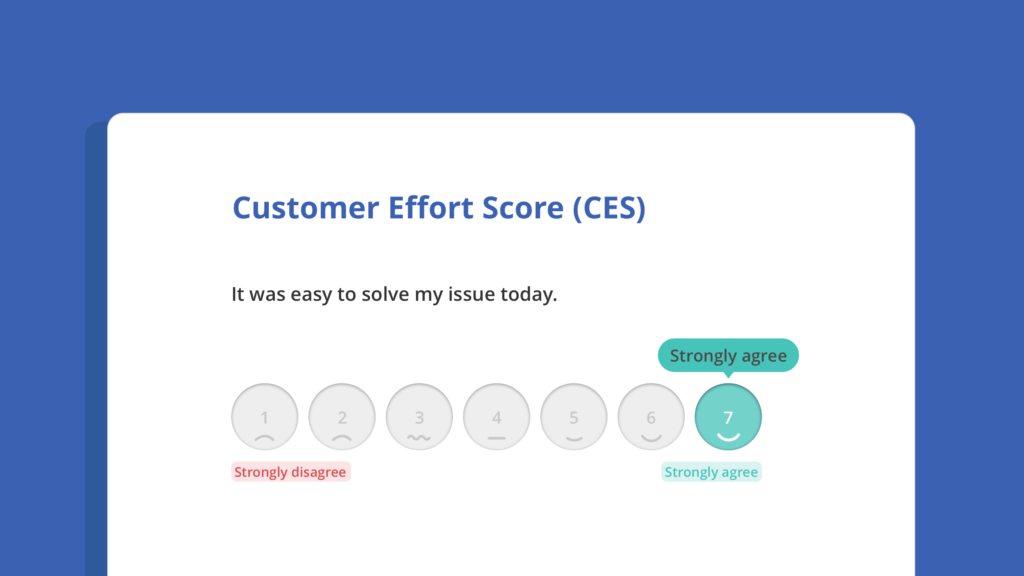
Why It Works
Every business wants satisfied customers. But do you know what is an even higher indicator of customer loyalty? Making the customer interaction as low-effort as possible. When you think about it, it makes perfect sense.
Have you ever faced an annoying problem when trying to buy something online? Maybe you couldn’t complete the purchase without setting up an online account. Or perhaps you had to verify your contact information, but the security code never arrived no matter how many times you requested it.
You may have contacted customer service to get the issue resolved. Or, the more likely option, you abandoned the purchase altogether. Make things too difficult for your customers, and they won’t stick around for long – and the numbers back it up.
One study found that 96% of customers with a high-effort service interaction become more disloyal compared to just 9% who have a low-effort experience (1). On the flipside, 94% of customers who reported low effort said they would likely purchase a product again (2).
With that in mind, eliminating high effort interactions from your customer journey will make a world of difference to your business. If brand loyalty is important to you, then ease of use is everything – for current customers and new customers alike.
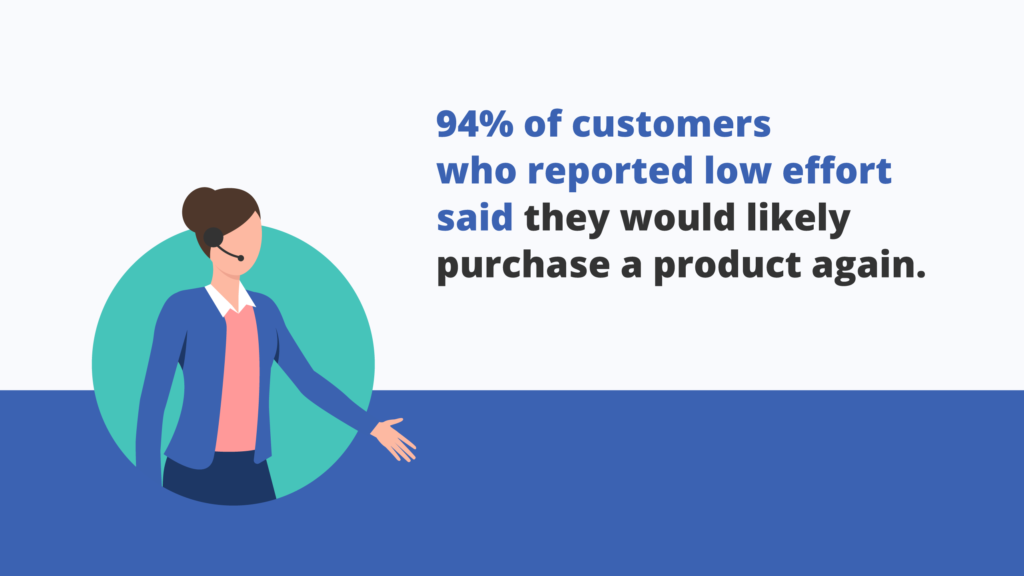
When Should You Use Customer Effort Score (CES)?
For best results, you should ask your CES question immediately after an action or interaction takes place. The experience is fresh in the customer’s mind, upping your chances of receiving honest feedback.
Because of this, it is an ideal choice for in-web and in-app surveys. These surveys appear right on the screen as your customer navigates your site, meaning you can capture instant feedback without disrupting the user experience.
While traditional surveys sometimes suffer from low response rates, these quick and easy surveys help you get as much valuable information as possible. You could use an in-web or in-app survey after:
- An online purchase or booking
- Creating an account
- Joining a loyalty program
- A subscription sign-up
- A customer service touchpoint
These are common customer journey touchpoints where high-effort interactions can occur, resulting in a negative customer experience (we’ll take a closer look at these further down the page).
Setting Up Your CES Survey
Now you know when to use Customer Effort Score, let’s explore what else you need to get the best results from your CES survey.
- Trigger – If you are asking for customer feedback directly after an action, consider what the best trigger for the survey will be. For instance, if you want to get feedback on your online ordering process, you might want to have the CES survey appear when the confirmation page loads.
- Distribution – As we mentioned, sharing a CES survey right from your website or app is the best way to get this kind of feedback. Other methods you might like to use are email or even live chat. A CES question can also be part of your broader customer satisfaction survey.
- Follow-up questions – While CES gives you a number to work with, on its own it doesn’t give any insight into why the customer gave that score. Adding a simple follow-up question is a great way to get more detailed feedback.
Example CES follow-up questions:
- We’d love to know why you gave us that rating?
- How did your effort compare to your expectations?
- What can we do to make ___ easier for you?
- Awesome! Anything else we can do to improve?
How To Improve Your Customer Effort Score (CES)
To understand how to improve your Customer Effort Score, first you need to know where you may be going wrong. So what kind of things could be hurting your customers’ experience? Here are a few common scenarios.
[ca-form id=”44600″ align=”right”]
- Having to explain the same problem multiple times to different people, for example once to the customer support team and again to a different department
- Starting an enquiry online and then having to make contact via phone
- Having to manually enter address details more than once for an online order
- Struggling to find an answer to a basic question on your website
As we touched on above, adding a follow-up question should let you know in more detail what your customers find frustrating. However, even without this information there are other tools you can use to help.
A great place to start is with a customer journey map. Part of the creation process is walking step-by-step through your customer journey, making it easier for you to spot flaws so you can take action to fix them. When used as part of a complete Voice of the Customer (VoC) program, you’ll start seeing even better results.
Advantages and Disadvantages Of Customer Effort Score (CES)
As with any customer satisfaction metric, Customer Effort Score (CES) isn’t perfect. Here are a few pros and cons to consider when introducing CES in your company.
Advantages
- It is one of the best ways to predict customer loyalty
- As CES is surveyed after specific actions, it gives you focused results that allow for quick changes
- When compared with other metrics, it is the strongest indicator of future purchase behaviour
- It is very easy to implement and is quick to get results
Disadvantages
- Without a follow-up question, you cannot determine why the action or interaction was high-effort for your customer
- As CES uses different scales (sometimes 1-5, other times 1-7) it’s a tricky customer satisfaction metric to compare against your competitors
- If you aren’t able to ask the CES question directly after the action or interaction, it may be harder to get accurate results
How Other Customer Satisfaction Metrics Compliment CES
Because no customer satisfaction metric will give you everything you need, it’s good practice to combine different metrics together. This way, you’ll cover as much ground as possible and maximise the results from your feedback. Let’s explore a couple other commonly used metrics and how they work with CES.
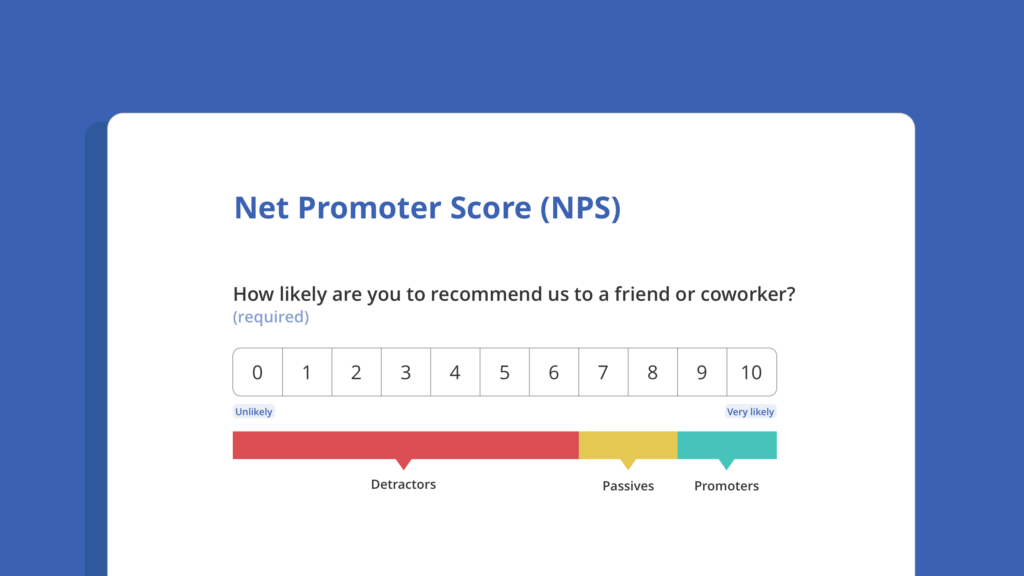
Net Promoter Score (NPS)
While CES surveys are used to gain insight into one particular action, NPS surveys measure the overall experience and in turn, customer loyalty over time. NPS is measured using a simple question: “On a scale from 0-10, how likely are you to recommend us to a friend or colleague?”
The NPS score is the percentage of people who scored 9 or 10, called “promoters”, minus the percentage of people who scored 0 to 6, known as “detractors”. For those of you wondering, customers who give scores of 7 and 8 are “passives”.
Like CES, an NPS question is often followed up with an open-ended question to get more details. For example, if the customer gave a low rating a follow-up question might simply be: “How could we improve?” This allows unhappy customers to share their thoughts and helps the business figure out where they need to improve.
NPS is a great complementary question to CES, as together they give a more holistic view of customer satisfaction and loyalty.
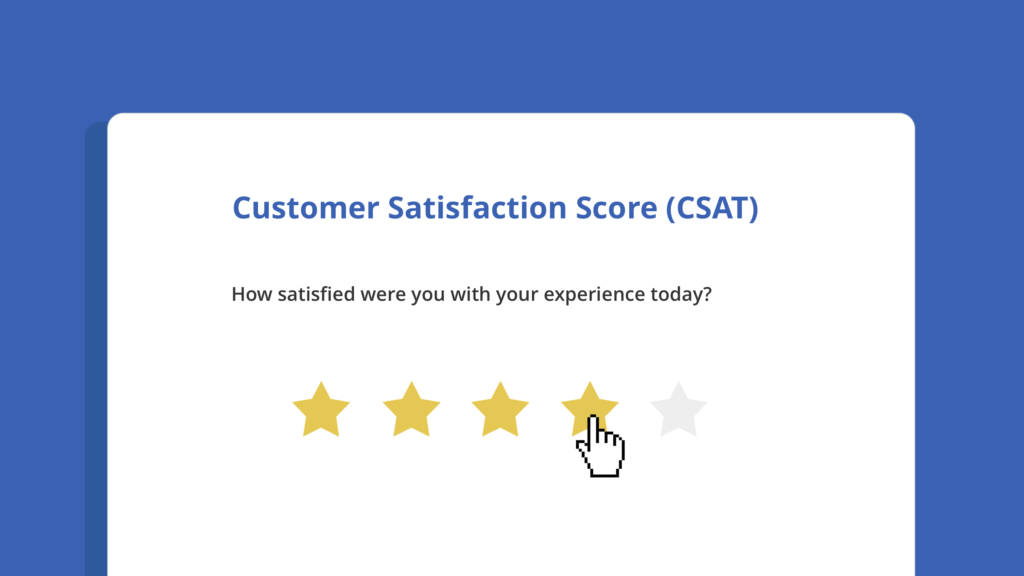
Customer Satisfaction Score (CSAT)
Like CES, the Customer Satisfaction Score (CSAT) captures a snapshot of customer feedback. Using a single question, CSAT surveys determine how happy customers were with a particular product, service or interaction. This includes questions like:
- How would you rate your live chat with customer service?
- Were you happy with your shopping experience today?
- How satisfied are you with our product?
CSAT questions are answered with either a numerical rating scale, a simple “yes” or “no” or even with a happy, neutral or sad face. The overall score is then expressed as a percentage, with 100% representing complete customer satisfaction.
As CSAT surveys are also used after a customer interaction, you may get better results if you use either CSAT or CES in combination with NPS. Which you choose will depend on your overall goals, and whether satisfaction or loyalty is the top priority for your business.
For a more in-depth look at these and other customer satisfaction metrics, check out our guide: How to measure customer satisfaction KPI: NPS, CSAT, CES, & CLI
How To Track Your Customer Effort Score (CES)
When it comes to improving your customer experience, optimising your workflow is key. If you try to do everything manually, it will become hard to keep on top of things and your well-intentioned plans will soon fall by the wayside.
Luckily, there are platforms like Customer Alliance that will help you not only collect and calculate your customer satisfaction scores, but also analyse your data and track your progress over time. To help keep you focussed, you can even set a CES target to work towards and a benchmark to ensure standards don’t start to slip.
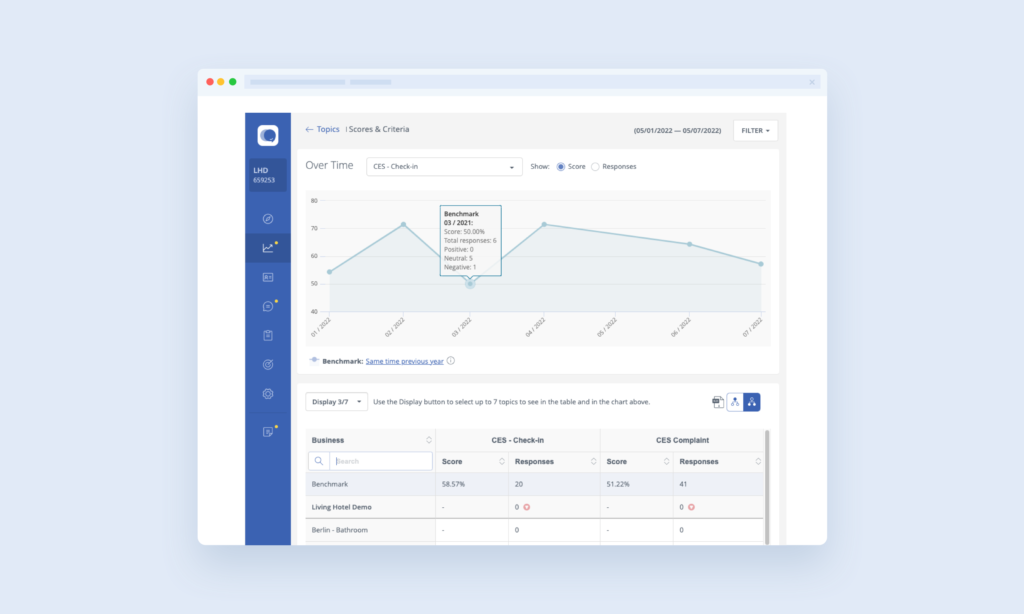
Our customer journey feature allows you to look at your customer satisfaction metrics across both the entire journey and individual touchpoints. That way, you can see at a glance exactly which areas of your business are affecting your performance. By taking advantage of automation, you can easily monitor and improve your Customer Effort Score with less manual work.
Conclusion
CES is one of several key customer satisfaction metrics that will fuel your business growth. When used in conjunction with things like customer surveys and review collection, Customer Effort Score can help companies improve customer experience, customer loyalty and overall satisfaction. This powerful metric is easy to implement and will quickly give you valuable insights into how customers interact with your business.
Of course, what’s more important than the score itself is the action you take to improve it. At Customer Alliance, our complete Voice of the Customer software instantly analyses your customer satisfaction metrics (including CES, NPS and CSAT) and customer feedback to give you valuable insights.
We make it simple to identify your unique satisfaction and dissatisfaction drivers, so you can create a strategy for success (with the data to back it up). Interested in learning more? Book your free, custom demo to see the platform in action.
Source:
- ‘The Effortless Experience: Conquering the New Battleground for Customer Loyalty’ by Matthew Dixon, Nick Toman and Rick DeLisi
- ‘Stop Trying to Delight Your Customers’, Harvard Business Review
